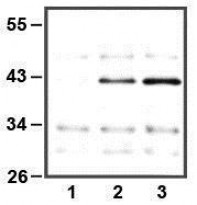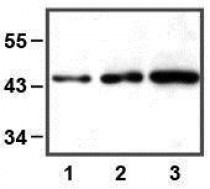ARG62348
anti-ERK1 antibody [E32]
anti-ERK1 antibody [E32] for Immunoprecipitation,Western blot and Human,Mouse
Developmental Biology antibody; Neuroscience antibody; Signaling Transduction antibody
Overview
| Product Description | Mouse Monoclonal antibody [E32] recognizes ERK1 |
|---|---|
| Tested Reactivity | Hu, Ms |
| Tested Application | IP, WB |
| Specificity | Recognizes only the ERK1 protein (e.g.: from human and mouse cells) |
| Host | Mouse |
| Clonality | Monoclonal |
| Clone | E32 |
| Isotype | IgG1 |
| Target Name | ERK1 |
| Antigen Species | Human |
| Immunogen | Recombinant full length ERK1 protein. |
| Conjugation | Un-conjugated |
| Alternate Names | MAPK 3; ERK1; P44MAPK; Microtubule-associated protein 2 kinase; Insulin-stimulated MAP2 kinase; HUMKER1A; PRKM3; P44ERK1; EC 2.7.11.24; p44-MAPK; Extracellular signal-regulated kinase 1; p44-ERK1; HS44KDAP; MAP kinase isoform p44; Mitogen-activated protein kinase 3; ERT2; MAP kinase 3; ERK-1 |
Application Instructions
| Application Suggestion |
|
||||||
|---|---|---|---|---|---|---|---|
| Application Note | The dilutions indicate recommended starting dilutions and the optimal dilutions or concentrations should be determined by the scientist. |
Properties
| Form | Liquid |
|---|---|
| Purification Note | Protein A affinity chromatography from mouse ascites fluid. |
| Buffer | 10mM PBS (pH 7.2) and 0.05% Sodium azide |
| Preservative | 0.05% Sodium azide |
| Concentration | 1 mg/ml |
| Storage Instruction | For continuous use, store undiluted antibody at 2-8°C for up to a week. For long-term storage, aliquot and store at -20°C or below. Storage in frost free freezers is not recommended. Avoid repeated freeze/thaw cycles. Suggest spin the vial prior to opening. The antibody solution should be gently mixed before use. |
| Note | For laboratory research only, not for drug, diagnostic or other use. |
Bioinformation
| Database Links |
Swiss-port # P27361 Human Mitogen-activated protein kinase 3 Swiss-port # Q63844 Mouse Mitogen-activated protein kinase 3 |
|---|---|
| Gene Symbol | MAPK3 |
| Gene Full Name | mitogen-activated protein kinase 3 |
| Background | ERK1 is a member of the MAP kinase family. MAP kinases, also known as extracellular signal-regulated kinases (ERKs), act in a signaling cascade that regulates various cellular processes such as proliferation, differentiation, and cell cycle progression in response to a variety of extracellular signals. This kinase is activated by upstream kinases, resulting in its translocation to the nucleus where it phosphorylates nuclear targets. Alternatively spliced transcript variants encoding different protein isoforms have been described. [provided by RefSeq, Jul 2008] |
| Function | Serine/threonine kinase which acts as an essential component of the MAP kinase signal transduction pathway. MAPK1/ERK2 and MAPK3/ERK1 are the 2 MAPKs which play an important role in the MAPK/ERK cascade. They participate also in a signaling cascade initiated by activated KIT and KITLG/SCF. Depending on the cellular context, the MAPK/ERK cascade mediates diverse biological functions such as cell growth, adhesion, survival and differentiation through the regulation of transcription, translation, cytoskeletal rearrangements. The MAPK/ERK cascade plays also a role in initiation and regulation of meiosis, mitosis, and postmitotic functions in differentiated cells by phosphorylating a number of transcription factors. About 160 substrates have already been discovered for ERKs. Many of these substrates are localized in the nucleus, and seem to participate in the regulation of transcription upon stimulation. However, other substrates are found in the cytosol as well as in other cellular organelles, and those are responsible for processes such as translation, mitosis and apoptosis. Moreover, the MAPK/ERK cascade is also involved in the regulation of the endosomal dynamics, including lysosome processing and endosome cycling through the perinuclear recycling compartment (PNRC); as well as in the fragmentation of the Golgi apparatus during mitosis. The substrates include transcription factors (such as ATF2, BCL6, ELK1, ERF, FOS, HSF4 or SPZ1), cytoskeletal elements (such as CANX, CTTN, GJA1, MAP2, MAPT, PXN, SORBS3 or STMN1), regulators of apoptosis (such as BAD, BTG2, CASP9, DAPK1, IER3, MCL1 or PPARG), regulators of translation (such as EIF4EBP1) and a variety of other signaling-related molecules (like ARHGEF2, FRS2 or GRB10). Protein kinases (such as RAF1, RPS6KA1/RSK1, RPS6KA3/RSK2, RPS6KA2/RSK3, RPS6KA6/RSK4, SYK, MKNK1/MNK1, MKNK2/MNK2, RPS6KA5/MSK1, RPS6KA4/MSK2, MAPKAPK3 or MAPKAPK5) and phosphatases (such as DUSP1, DUSP4, DUSP6 or DUSP16) are other substrates which enable the propagation the MAPK/ERK signal to additional cytosolic and nuclear targets, thereby extending the specificity of the cascade. [UniProt] |
| Research Area | Developmental Biology antibody; Neuroscience antibody; Signaling Transduction antibody |
| Calculated MW | 43 kDa |
| PTM | Phosphorylated upon KIT and FLT3 signaling (By similarity). Dually phosphorylated on Thr-202 and Tyr-204, which activates the enzyme. Ligand-activated ALK induces tyrosine phosphorylation. Dephosphorylated by PTPRJ at Tyr-204. |
Images (2) Click the Picture to Zoom In
-
ARG62348 anti-ERK1 antibody [E32] IP image
Immunoprecipitation: (1) 10μg; (2) 25μg; (3) 50μg of HeLa cell lysate immunoprecipitated by 1μl of ARG62348 anti-ERK1 antibody [E32].
-
ARG62348 anti-ERK1 antibody [E32] WB image
Western Blot: HEK293 cell lysate; (1) 5 μg, (2) 10 μg, and (3) 30 μg of cell lysate stained with ARG62348 anti-ERK1 antibody [E32] at 1:1000 (1 μg/mL) dilution









